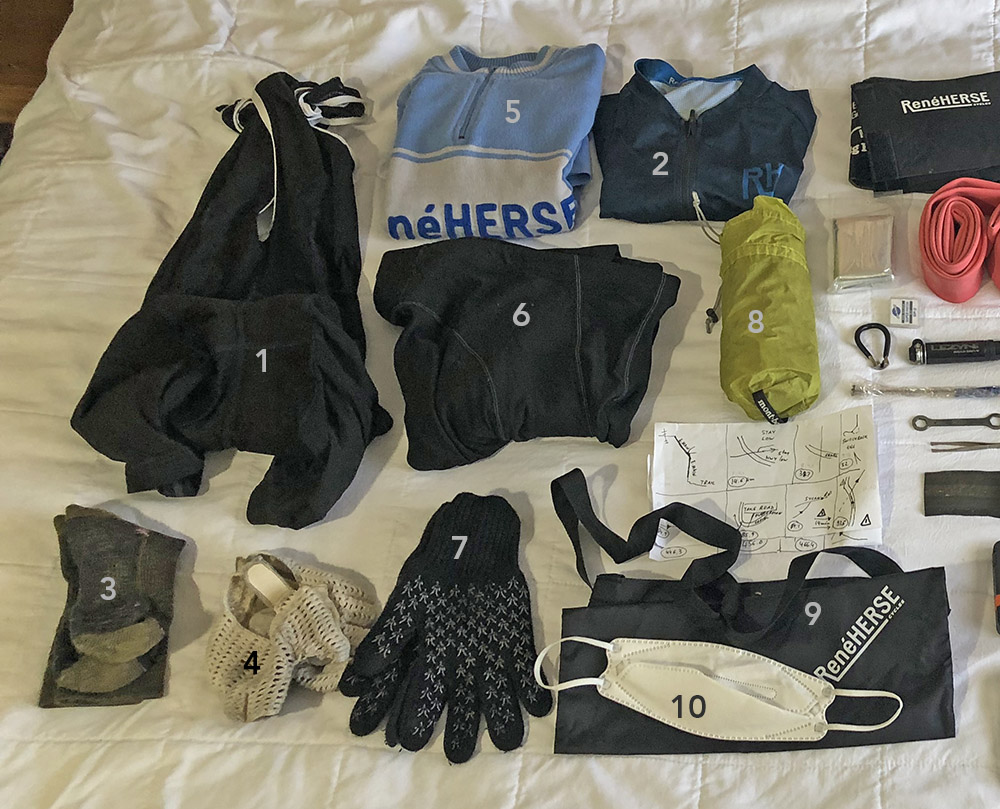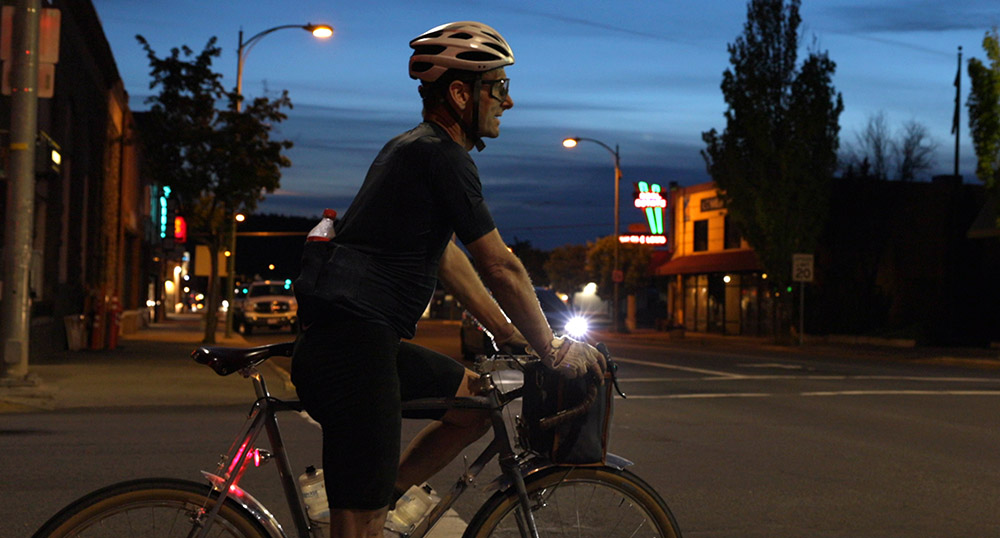Packing for the Oregon Outback
People have commented to the stats of the Oregon Outback FKT. I find it interesting to review the ride – what went right and what could be improved in the future. These numbers can also help others who plan a long ride.
- Distance: 585 km / 363 miles
- Elevation gain: 4,382 m / 14,376 ft
- Total time: 26:13 hours
- Total off-bike time: approx. 26 minutes, plus opening and closing 30+ gates on the OC&E Trail
- Average speed (incl. stops): 22.3 km/h / 13.8 mph
- Calories consumed: approx. 7,200 kcal (approx. 290 kcal/h)
- Liquid consumed: approx. 5.5 l water; 2.5 l Coca-Cola; 0.5 l apple juice

The things I carry with me have evolved over many adventures in the Cascade Mountains. Every piece is selected for performance and light weight. To me, it doesn’t make sense to install titanium bolts on the bike and then carry a heavy multi-tool… That said, I don’t cut it too close with minimalist packing, because the weight penalty of a few extra items is small compared to the risk of not being able to complete the ride. (It’s a long walk to the next town!)

The clothing is a simple layering system:
Base/hot-weather layer:
1 Rapha Classic bib shorts (comfortable for 30+ hours)
2 Rene Herse x Velocio Ultralight jersey (superlight, breathable)
3 Smartwool socks (comfortable in all temps)
4 Alex Singer leather gloves (keep my palms from getting abraded on rough terrain)
Not shown: Dromarti leather spd-compatible shoes (lightweight, breathable, no hot feet)
Cool weather layer goes over base layer:
5 Rene Herse x Woolistic Merino long-sleeve jersey (prototype; adjusts to a wide range of temps)
6 Ground Effect wool tights (warm legs are essential for me)
7 Ibex wool gloves (discontinued) (I hate cold fingers!)
Very cold temps or rain:
8 Montbell Ultralight breathable shell (bought in Japan, may not be available in U.S.)
Other:
9 Rene Herse musette bag for extra food after supply stops (easy to eat from while riding)
10 Face mask
Not shown: Helmet, cycling glasses
For me, wool clothing is essential for efficient riding. Wool continues to insulate when it’s wet – better than any synthetics I’ve tried – so there’s no need to add and remove layers when going up- and downhill. That’s significant time savings and also added comfort. Similarly, the (real) leather shoes have transformed my cycling. I used to get burning feet during hard rides in hot weather. It could get so bad that I stopped to dip my feet in puddles by the road, only to get cold when my socks didn’t dry before night fell. No more – now my feet are just comfortable all the time.

For a ride as remote and rough as the Oregon Outback, I carry a few more tools than usual:
11 Space blanket in case I need to sleep (and as a last resort if I get stuck somewhere cold)
12 Rene Herse Rinko pads to protect the bike on the train. During the ride, they go into the bottom of the handlebar bag as a cushioning layer.
13 Tools: 2 spare tubes, glueless patch kit, spoke wrench, 3 spokes and nipples, 10 x 11 box wrench, 4 x 5 mm Allen, tweezers (to remove small debris stuck in a tire after a flat).
14 Tire boot (old piece of tire casing)
15 Small headlamp (to read cue sheet, fix flats in the dark)
Not shown: Toilet paper
I rarely break spokes, especially on new wheels, so I usually don’t carry spares. But at the last moment, I thought that 20 grams of extra weight (including the wrench) were good insurance, and I packed them. I rolled the into the long frame protection pad – otherwise, they might chafe through my handlebar bag’s fabric on the rough roads and trails of the Oregon Outback. I also decided to bring a second pump, just in case. (My bike is equipped with a superlight frame pump.) I’ve had a pump fall apart on rough gravel roads… In the future, I’m looking for a lighter emergency pump to save a little weight.

Navigation is another important aspect.
16 Tracker (shows my progress on the map and validates the ride)
17 GPS (not always reliable)
18 Power bank and cable (in case electronics need charging)
19 Route sheet (my main resource for navigation)
Not shown: Cell phone (with course downloaded so it’s available off-line)

Food is essential to keep going. One of the biggest challenges on FKT rides is to keep fueled. My body can only digest a certain amount of calories (about 300/hour), which is about what I burn. If I go into a deficit, I cannot catch up without slowing down. However, I also need to be careful not to overload my stomach, so I slow my eating schedule if my stomach feels full. It’s a delicate balance. Lael Wilcox once said about long races like the Tour Divide: “You turn into an eating machine!”
My diet when riding all-out is very different from what I eat during casual tours or in daily life. ‘Real’ foods made from natural ingredients are usually my preference for taste and health, but during an FKT ride, there is no energy to spare for digestion. Simple foods are easily absorbed, especially during hot weather and all-out efforts. For me, energy bars become impossible to chew and swallow when I’m riding close to the max, so I use different foods.

For rides shorter than 30 hours, I find it more efficient to carry what I need than to try to buy it in places that may or may not have what I want. For me, it’s key to start a ride well-hydrated and nourished (but not overload my stomach). For breakfast before the FKT, I drank about 1 l of apple juice diluted with water, plus ate a bowl of granola (with apple juice rather than milk). On the bike, I carried:
20 Electrolyte tablets (for my water bottles)
21 Lip balm (important for dry eastern Oregon climate)
22 Gummy bears (easy to eat and digest; some electrolytes; lots of calories; 450 kcal/pack)
23 Ensure Plus (easy to consume and digest; 350 kcal/bottle)
24 Dried mango (sugar, electrolytes)
25 Yokan bean paste (lots of calories; easy to eat; 130 kcal/pack)
26 Chocolate (didn’t eat on this ride)
27 Electrolyte gummies (for hot and dry weather)
Not shown: Chocolate chip cookies from Macrina Bakery in Seattle (easy to eat; 200 kcal/cookie)
In the end, I didn’t eat all the food I brought, but cutting it too close is not a good idea: If I run out of food in the middle of nowhere, I bonk and have to slow down a lot as my body switches to fat burning. In fact, I did lose 1 kg of body fat during the ride, which amounts to another 7,000 kcal, so the total energy consumption during the ride was somewhere around 14-15,000 kcal.

Drinking may be even more important than eating. During the ride, I refilled two water bottles every 200 km (120 miles), adding electrolyte tablets to prevent cramps. I filled the third bottle with Ensure Plus, making it easy to drink on the rough gravel. At each stop, I bought two bottles of Coca-Cola that I carried in my jersey pockets or musette bag. During the day, I added electrolyte tablets to the Coke (making it fizz a lot!). After 400 km, my body’s electrolytes still felt out of balance, despite all my efforts to replenish them, so I drank a bottle of apple juice.
Everybody’s needs are different. Some riders need to drink more; others may eat less. Some can ride in shorts no matter how cold it is; others dress warmly. For me, how much I need to eat and drink depends on many factors that are hard to predict. I try to listen to my body, combined with the experience of previous rides to prevent going into a deficit. Experiment what works for you! Being well fueled and comfortable is key to enjoying the ride!
Photo credits: Rugile Kaladyte (Photos 1, 6)



